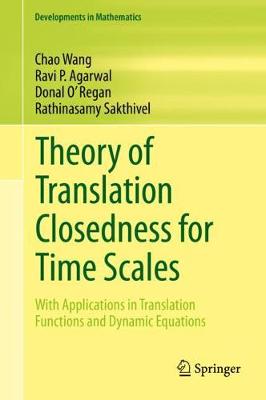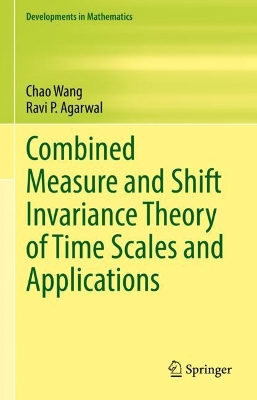Developments in Mathematics
3 primary works
Book 62
Theory of Translation Closedness for Time Scales
by Chao Wang, Ravi P. Agarwal, Donal O' Regan, and Rathinasamy Sakthivel
Published 6 May 2020
This monograph establishes a theory of classification and translation closedness of time scales, a topic that was first studied by S. Hilger in 1988 to unify continuous and discrete analysis. The authors develop a theory of translation function on time scales that contains (piecewise) almost periodic functions, (piecewise) almost automorphic functions and their related generalization functions (e.g., pseudo almost periodic functions, weighted pseudo almost automorphic functions, and more). Against the background of dynamic equations, these function theories on time scales are applied to study the dynamical behavior of solutions for various types of dynamic equations on hybrid domains, including evolution equations, discontinuous equations and impulsive integro-differential equations.
The theory presented allows many useful applications, such as in the Nicholson`s blowfiles model; the Lasota-Wazewska model; the Keynesian-Cross model; in those realistic dynamical models with a more complex hibrid domain, considered under different types of translation closedness of time scales; and in dynamic equations on mathematical models which cover neural networks. This book provides readers with the theoretical background necessary for accurate mathematical modeling in physics, chemical technology, population dynamics, biotechnology and economics, neural networks, and social sciences.
The theory presented allows many useful applications, such as in the Nicholson`s blowfiles model; the Lasota-Wazewska model; the Keynesian-Cross model; in those realistic dynamical models with a more complex hibrid domain, considered under different types of translation closedness of time scales; and in dynamic equations on mathematical models which cover neural networks. This book provides readers with the theoretical background necessary for accurate mathematical modeling in physics, chemical technology, population dynamics, biotechnology and economics, neural networks, and social sciences.
Book 71
This book examines in detail approximate fixed point theory in different classes of topological spaces for general classes of maps. It offers a comprehensive treatment of the subject that is up-to-date, self-contained, and rich in methods, for a wide variety of topologies and maps. Content includes known and recent results in topology (with proofs), as well as recent results in approximate fixed point theory.
This work starts with a set of basic notions in topological spaces. Special attention is given to topological vector spaces, locally convex spaces, Banach spaces, and ultrametric spaces. Sequences and function spaces—and fundamental properties of their topologies—are also covered. The reader will find discussions on fundamental principles, namely the Hahn-Banach theorem on extensions of linear (bounded) functionals; the Banach open mapping theorem; the Banach-Steinhaus uniform boundedness principle; and Baire categories, including some applications. Also included are weak topologies and their properties, in particular the theorems of Eberlein-Smulian, Goldstine, Kakutani, James and Grothendieck, reflexive Banach spaces, l_{1}- sequences, Rosenthal's theorem, sequential properties of the weak topology in a Banach space and weak* topology of its dual, and the Fréchet-Urysohn property.
The subsequent chapters cover various almost fixed point results, discussing how to reach or approximate the unique fixed point of a strictly contractive mapping of a spherically complete ultrametric space. They also introduce synthetic approaches to fixed point problems involving regular-global-inf functions. The book finishes with a study of problems involving approximate fixed point property on an ambient space with different topologies.
By providing appropriate background and up-to-date research results, this book can greatly benefit graduate students and mathematicians seeking to advance in topology and fixed point theory.
This work starts with a set of basic notions in topological spaces. Special attention is given to topological vector spaces, locally convex spaces, Banach spaces, and ultrametric spaces. Sequences and function spaces—and fundamental properties of their topologies—are also covered. The reader will find discussions on fundamental principles, namely the Hahn-Banach theorem on extensions of linear (bounded) functionals; the Banach open mapping theorem; the Banach-Steinhaus uniform boundedness principle; and Baire categories, including some applications. Also included are weak topologies and their properties, in particular the theorems of Eberlein-Smulian, Goldstine, Kakutani, James and Grothendieck, reflexive Banach spaces, l_{1}- sequences, Rosenthal's theorem, sequential properties of the weak topology in a Banach space and weak* topology of its dual, and the Fréchet-Urysohn property.
The subsequent chapters cover various almost fixed point results, discussing how to reach or approximate the unique fixed point of a strictly contractive mapping of a spherically complete ultrametric space. They also introduce synthetic approaches to fixed point problems involving regular-global-inf functions. The book finishes with a study of problems involving approximate fixed point property on an ambient space with different topologies.
By providing appropriate background and up-to-date research results, this book can greatly benefit graduate students and mathematicians seeking to advance in topology and fixed point theory.
Book 77
Combined Measure and Shift Invariance Theory of Time Scales and Applications
by Chao Wang and Ravi P. Agarwal
Published 30 September 2022
This monograph is devoted to developing a theory of combined measure and shift invariance of time scales with the related applications to shift functions and dynamic equations. The study of shift closeness of time scales is significant to investigate the shift functions such as the periodic functions, the almost periodic functions, the almost automorphic functions, and their generalizations with many relevant applications in dynamic equations on arbitrary time scales.
First proposed by S. Hilger, the time scale theory—a unified view of continuous and discrete analysis—has been widely used to study various classes of dynamic equations and models in real-world applications. Measure theory based on time scales, in its turn, is of great power in analyzing functions on time scales or hybrid domains.
As a new and exciting type of mathematics—and more comprehensive and versatile than the traditional theories of differential and difference equations—, the time scale theory can precisely depict the continuous-discrete hybrid processes and is an optimal way forward for accurate mathematical modeling in applied sciences such as physics, chemical technology, population dynamics, biotechnology, and economics and social sciences.
Graduate students and researchers specializing in general dynamic equations on time scales can benefit from this work, fostering interest and further research in the field. It can also serve as reference material for undergraduates interested in dynamic equations on time scales. Prerequisites include familiarity with functional analysis, measure theory, and ordinary differential equations.
First proposed by S. Hilger, the time scale theory—a unified view of continuous and discrete analysis—has been widely used to study various classes of dynamic equations and models in real-world applications. Measure theory based on time scales, in its turn, is of great power in analyzing functions on time scales or hybrid domains.
As a new and exciting type of mathematics—and more comprehensive and versatile than the traditional theories of differential and difference equations—, the time scale theory can precisely depict the continuous-discrete hybrid processes and is an optimal way forward for accurate mathematical modeling in applied sciences such as physics, chemical technology, population dynamics, biotechnology, and economics and social sciences.
Graduate students and researchers specializing in general dynamic equations on time scales can benefit from this work, fostering interest and further research in the field. It can also serve as reference material for undergraduates interested in dynamic equations on time scales. Prerequisites include familiarity with functional analysis, measure theory, and ordinary differential equations.


